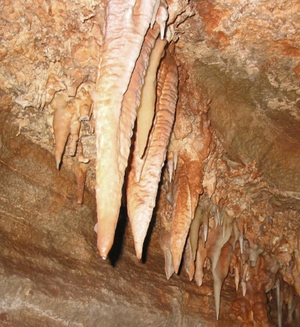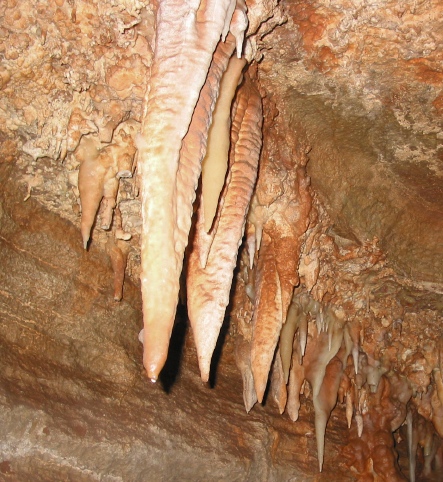Ancient Rainfall, Carved in Stone
Stalactites grow from cave ceilings not as dull cones but often sporting elegant corrugations. In Physical Review Letters, two Italian researchers now explain these mysterious, wavy patterns using standard fluid mechanics. Their theory shows that the horizontal ripples form because spatially periodic patterns arise in the rate of mineral deposits from the water flowing down the stalactite. Starting from this model, climate scientists might in the future use stalactite surface structure to reconstruct variations in precipitation patterns over tens of thousands of years.
In certain caves, a tiny but steady flow of water from above brings a constant supply of minerals—especially calcite, which is calcium carbonate—to add to slow-building structures such as stalactites and their lowly siblings, stalagmites. Some stalactites build up horizontal, wavy patterns called crenulations. These hills and valleys repeat at regular lengths, usually between five and ten millimeters, and they slowly migrate upward, according to data from stalactite cross sections.
Such structures must arise from the interplay of fluid dynamics—the flow of water that brings fresh material to the mineral growth—and the deposition process. In an idealized, symmetric situation, water moves in layers parallel to a flat rock surface, and the water’s solute concentration varies smoothly from top to bottom, decreasing as the water slides down a stalactite and deposits calcite. At any given point on the rock surface, the rate of deposition depends mainly on the local concentration of solutes. For crenulations to appear, something must cause the fluid motion—and the concentrations of solutes it carries—to vary in a periodic fashion.
Researchers have built models in which they imposed perturbations on the smooth surface of the stalactite and watched the deposition patterns change over time. But in previous attempts, such as one by Nigel Goldenfeld, of the University of Illinois at Urbana-Champaign, and his student Patrick Chan [1], the system spontaneously tended to drift back to a “flat” state, one without waves.
Past models have assumed that the flow remains everywhere parallel to the rock surface and thus were too simplistic, says Carlo Camporeale, an environmental engineer at the Polytechnic University of Turin, Italy. In their latest work, Camporeale and his Turin colleague Luca Ridolfi have developed a model that allows for more complicated fluid flow. They also included equations for the chemical reactions and the resulting rate of calcite deposition. The team found that crenulations of a specific wavelength grow because of eddies that form as water moves across the “hills.” The eddies thus reinforce the formation of the hills by generating a maximum in the concentration of solutes just above each hill, which maximizes the calcite deposition there, as well as causing the crenulations to slowly migrate upward. Their equations reproduce the observed patterns: the rock surface grows waves of characteristic lengths, and the waves migrate upward year after year. Other tiny variations in the surface topography might occur as well, but they are rapidly smoothed out; only the crenulations of a single wavelength persist.
Hoping that the crenulation wavelength could provide a measure of ancient greenhouse gases, Camporeale and Ridolfi tried tweaking several parameters in their model, such as temperature and the carbon dioxide concentration in the surrounding air. But they were disappointed, Camporeale says, because the wavelength barely budged. The wavelength is mainly determined by “the physics of falling films,” the team writes, especially the surface tension of water.
On the other hand, the rate of upward migration of the ripples, which is visible in stalactite cross sections, depends strongly on the total flow of water, according to the model. The trickle of water into caves depends on precipitation aboveground, so crenulations could give precious information about ancient climate, Camporeale says. But he says that demonstrating that crenulations are a reliable proxy for precipitation patterns will require extensive studies and cross-checks.
“By combining more detailed modeling of the geochemistry with the fluid dynamics, Camporeale and Ridolfi appear to have finally shown how the crenulations arise,” says Goldenfeld. Most importantly, he adds, their results explain why the wavelength is “essentially universal.”
–Davide Castelvecchi
Davide Castelvecchi is a freelance science writer in Rome.
References
- P. Y. Chan and N. Goldenfeld, “Steady States and Linear Stability Analysis of Precipitation Pattern Formation at Geothermal Hot Springs,” Phys. Rev. E 76, 046104 (2007)





